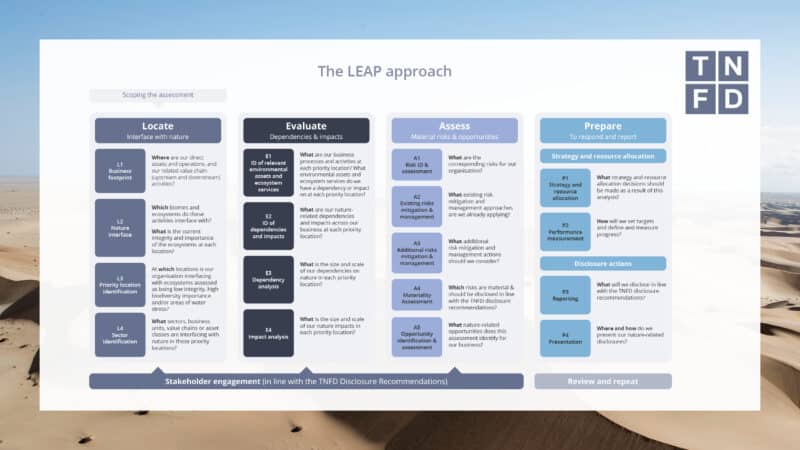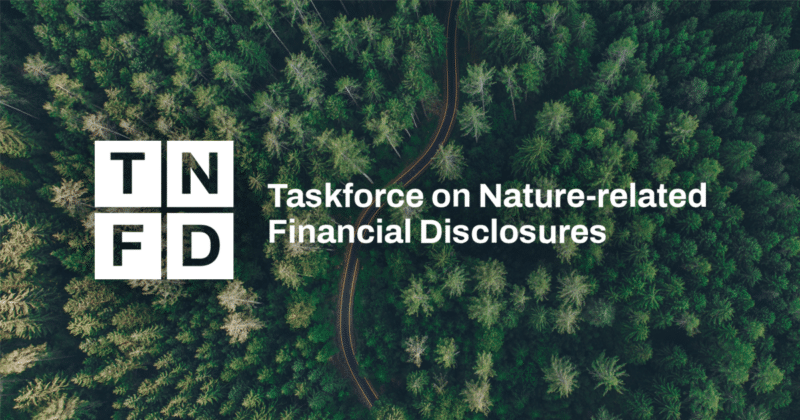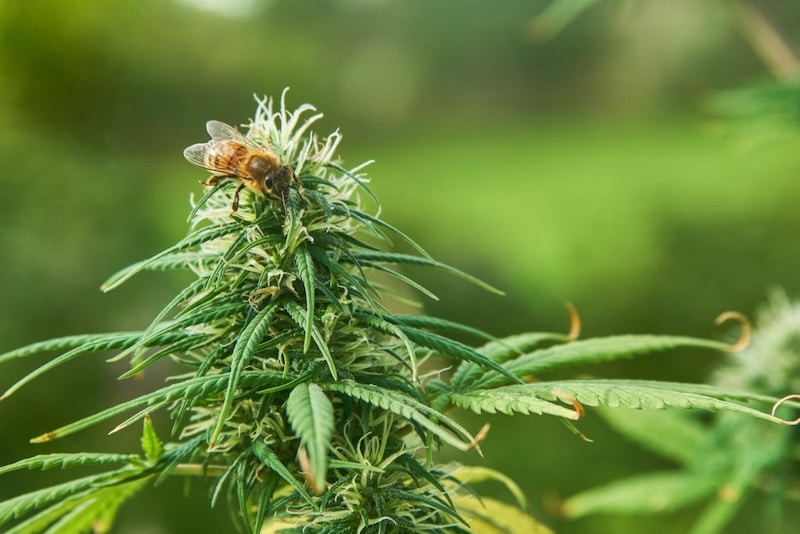Contents:
- What is the TNFD?
- What is the TNFD Developing?
- Why is the TNFD Developing the New Framework?
- What are “Nature-Related Opportunities”?
- How is the TNFD’s New Framework Different from Previous Frameworks?
- How will the TNFD Guide Corporations with this New Framework?
- Why does Nature-Related Financial Disclosure Matter?
- Why Should Corporations Voluntarily Use the TCFD and TNFD Frameworks?
- How Do Pollinators Relate to the New TNFD Framework?
- FAQs
More than half of global GDP — US$44 trillion of economic value generation — is moderately or highly dependent on nature and its services, per the World Economic Forum (WEF). Depleting the world’s natural resources creates risk, and nature needs to be integrated into business decisions and risk management to help protect our planet.
What is the TNFD?
The story of the Taskforce on Nature-Related Financial Disclosures (TNFD) starts in 2017 with the creation of the Taskforce on Climate-Related Financial Disclosures (TCFD). The Financial Stability Board (FSB) created TCFD to help companies provide better information relating to their climate risks and opportunities, along with what their management teams were doing to mitigate or take advantage of these risks and opportunities. This was motivated by the growing demand to go beyond simple disclosure and have companies, corporations, and organizations actually analyze and discuss how climate change is impacting them.
In recent years, that demand has expanded beyond just climate risks and opportunities to include how companies impact/are impacted by the planet’s ecosystems and biodiversity – in other words, nature-related risks and opportunities. The FSB responded in 2021 by establishing a sister disclosure set for TCFD, with biodiversity and ecosystem health at the forefront. This is TNFD.
The TNFD’s mission is to provide a framework for how corporations can address environmental risks and opportunities, with the ultimate goal of channeling capital flows into positive action. Emulating the existing recommendations on climate-related risk disclosures from the TCFD, the TNFD will recommend new disclosures for corporations that capture nature-related risks.
Beyond just disclosure, the idea is that by increasing awareness of the financial repercussions of nature loss and environmental degradation, businesses may choose to adopt more sustainable practices and support the regeneration and restoration of nature.
What is the TNFD Developing?
The TNFD is developing a decision-useful risk management and disclosure framework for corporations to use when reporting on evolving nature-related risks and opportunities. In other words, corporations can use this framework to assess and disclose how they impact, and are impacted by, nature. This reporting could then support the flow of capital toward nature-positive activities and outcomes.
The TNFD has 40 individual members, but they are joined by more than 1,000 institutions in the TNFD Forum, operating in an open-innovation approach that encourages market participants to support the development of the framework. The hope is that this collaborative process will improve the framework’s relevance, usability, and effectiveness.
After two years of design and development through an open innovation process, the TNFD published its finalized Recommendations Framework for nature-related risk management and disclosure in September 2023.
Why is the TNFD Developing the New Framework?
As mentioned earlier, the present focus for much of environmental reporting and regulations has been upon mitigating atmospheric climate change. While also vitally important, climate issues do not encompass all of the risks and opportunities intertwined with nature as a whole. Nature and environmental risks include loss of biodiversity and degradation of ecosystems, while climate risk is an interdependent but distinct issue.
The negative human impact on our natural world risks the ecological foundations of our global economy and threatens the stability of life on Earth. Human activities have already severely altered 75% of land and 66% of marine environments, and caused the loss of 83% of wild mammals and half of all plants, according to the Intergovernmental Science-Policy Platform on Biodiversity and Ecosystem Services (IPBES). Humanity is currently using the equivalent of 1.75 Earths to maintain our current way of life, and the ecosystems of our planet cannot keep up with our demands.
According to the United Nations, between 2015 and 2020, we lost approximately 10 million hectares of forests (an area the size of Iceland) per year, and globally more than two thirds of our ocean ecosystems are now damaged, degraded or modified.
This loss of ecosystems and species leads to the loss of benefits for people and nature. From an economic perspective, it is estimated that $10 trillion in global GDP could be lost by 2050 if ecosystem services continue to decline.
“Biodiversity risk is financial risk.” – Brett Hundley, Managing Director of FTI Consulting for ESG & Sustainability Advisory Solutions
As nature-related risks evolve and accelerate, it is critical that we transform the relationship between companies, societies, and the natural world. We have to be taking a more holistic approach to monitoring, regulating, and reporting our impact on the planet – beyond simply greenhouse gas emissions and carbon footprints. Doing so will safeguard the financial well-being of corporations by ensuring they are aware of and mitigating their climate and nature-related risks, as well as motivating them to take advantage of nature-related opportunities. (It will also protect the planet and its ecosystems, which we must keep healthy for ourselves and future generations to come.)
The TNFD’s framework will capture both the risks and opportunities from nature to/for the activities of corporations, and the risks and opportunities to/from corporations for nature.
What are “Nature-Related Opportunities”?
Similarly to how corporations will be guided through how to measure and mitigate risks arising from their organization’s interactions with nature, they will also be helped to consider their current and potential positive impacts, through the concept of “nature-related opportunities.”
The TNFD defines nature-related opportunities as ”Activities that create positive outcomes for corporations and nature by avoiding or reducing impact on nature or contributing to its restoration.”
Nature-related opportunities can both reduce nature-related risks and also help corporations increase their overall profits. Reconfiguring operations to use less energy and produce less waste, for example, allows a company to become more environmentally friendly while reducing energy and materials cost.
Additionally, a recent global study found that consumers are four to six times more likely to purchase, protect, and champion purpose-driven companies, and products are increasingly able to command a premium price if they are sustainably produced. Companies looking to practice corporate social responsibility can greatly benefit from utilizing the TCFD and TNFD frameworks.
How is the TNFD’s New Framework Different from Previous Frameworks?
According to Brett Hundley, Managing Director of FTI Consulting for ESG & Sustainability Advisory Solutions, the TNFD framework is very similar to the TCFD framework.
“Both of these ask for a common set of disclosures for all companies, starting with tracking specific metrics and targets, followed by narrative responses on how companies manage risk, create related strategies, and construct proper corporate governance,” Hundley said.
Several existing frameworks, such as SASB and GRI, are solely focused on disclosure. They ask that corporations track, monitor, and then report their climate metrics, such as greenhouse gas emissions. However, they stop there. The TCFD and TNFD take it further and guide corporations through analysis of these metrics to determine appropriate action in response to the learnings from their reporting.
“The other great thing about TCFD and TNFD is that they both require companies to evaluate future climate scenarios and how these scenarios might impact the financial health of their business. Other disclosures don’t do this,” Hundley said.
A complicating factor for developing disclosures on nature-related risks is that there is no equivalent to simple metrics, such as global temperature or greenhouse gas emissions, that have helped galvanize efforts to tackle climate-related risk. Nature-related risk entails a more complex array of factors and is more localized, and mitigating efforts have to be individually tailored to match the unique conditions and needs of each location.
The TNFD framework will comprehensively aid corporations as they navigate through the process of measuring and mitigating the risks arising from their organization’s interactions with nature (by their own actions or in their supply chain).
“It will ask companies to evaluate ecosystem services provided by nature to the company, with a hope that business leaders will start to better understand just how much their companies rely on nature and biodiversity. All of this will be done on a location-by-location basis … it’s really the first of its kind out there,” Hundley said.
How will the TNFD Guide Corporations with this New Framework?
The TNFD addresses the individualized nature of assessing nature-related risks by providing new guidance for assessing these risks using the LEAP approach – Locate, Evaluate, Assess, Prepare. The Prepare step is where corporations will determine what strategy and resource allocation decisions should be made as a result of their analysis, along with how they will set targets and define and measure progress.
The kind of assessment and analysis required by the TNFD is more complex than previous frameworks. Corporations will have to look at their risk and impact on a location-by-location basis, which will mean looking at all of their locations across the globe, as well as the risk and impact of their supply chain.
For an agricultural poultry company, for example, past risk assessment would look like assessing the health of their poultry, the cost of shipping and transport, and the cost of corn and soybeans. The TNFD will have them dive deeper, such as looking at the effects of the corn production on the ecosystem it is grown in. From there, the framework calls for the corporation to strategize and set targets in place for efforts to offset the negative impacts and contribute to the restoration of the biodiversity and health of the ecosystem.
At the end of the day, the farmers who are growing the corn are doing so to meet the demand put upon them by these corporations. Therefore, as the larger, more profitable entity, corporations are responsible for mitigating the environmental impact and aiding in restoring the ecosystem health of the locations where their supply chain is located.

Why does Nature-Related Financial Disclosure Matter?
The mission to push businesses, corporations, and corporations to be more sustainable and contribute to the preservation and protection of the planet is not new. However, existing frameworks, like the one developed by the TCFD, are primarily focused on climate risks and opportunities, rather than nature risks and opportunities.
If the TNFD framework can reach the same level of acceptance as the TCFD one, it will put nature at the forefront of discussion and add nuance to the sustainability conversations – which too often is reduced to just carbon emissions. By raising nature risk and opportunity disclosures to the corporate board level, companies will be pushed to take more meaningful action with greater transparency, accountability, and oversight.
Several countries are mandating that corporations conduct climate and nature risk assessments and disclosures to then inform how they can mitigate that risk, lower their negative environmental impact, and aid in restoring ecosystems their business operations have impacted. For corporations that are not in countries where this is mandated, it is still a smart business move to voluntarily utilize and follow the TCFD and TNFD frameworks.
Why Should Corporations Voluntarily Use the TCFD and TNFD Frameworks?
According to Hundley, investors and stakeholders are increasingly demanding climate and nature-related risk disclosure and mitigating action from corporations in exchange for continued investment of capital. Because, as Hundley puts it, “whether it is climate risk, or nature risk or any other type of risk, investors want and need to know about the risks facing a business before they invest money into a company.”
Utilizing the TCFD and TNFD frameworks demonstrates good governance, which is something investors and stakeholders look for and expect in corporations. Additionally, consumers, employees, activists, and policymakers alike are putting pressure on corporations to use their power, influence, and impact for the good of the planet.
It is no longer enough to simply meet profit margins, growth projections, customer acquisition targets, etc. Corporations are expected to take a holistic view of their operations, assess their impact, and take action on behalf of the planet and its ecosystems.
Climate and nature-related risks need to be disclosed in order to motivate that mitigating action. Corporations need to understand just how much their profitability depends on the climate and nature – revenue can’t be generated if raw materials, natural resources, and ecosystem services disappear.
“Profit systems exist within natural systems, not the other way around. In today’s society, we all tend to make decisions solely tied to the impacts they might have on the economy, jobs, etc., when we actually need to be thinking equally, if not more, about how decisions impact the natural world. Because without a properly functioning natural world, there is no economy.” – Brett Hundley, Managing Director of FTI Consulting for ESG & Sustainability Advisory Solutions
How Do Pollinators Relate to the New TNFD Framework?
The TNFD framework focuses on moving from nature-negative activities to nature-positive activities. An impactful way for corporations to positively impact the environment is by bringing beehives to their site and/or the locations of their suppliers, promoting the local biodiversity and improving ecosystem services. In addition, they can participate in habitat restoration initiatives (such as planting pollinator gardens).
As pollination is one of the critical ecosystem services threatened by habitat loss, protecting and promoting pollinator health is one nature-related opportunity corporations can take advantage of. Bringing bees to a property, particularly scientifically-managed beehives that contribute data to pollinator health research, helps to promote the growth of a healthy ecosystem. Additionally, corporations that rely upon agricultural production can strengthen their suppliers’ production by providing them with bees. This will enhance the yield, health, and resiliency of crops through increased pollination – lowering costs and increasing profits in the long run.
Landscaping with pollinators in mind is another nature-related opportunity, as many pollinator-friendly landscaping practices reduce an organization’s negative impact on the environment and improve their positive impact. For an example of reducing negative impact, minimizing pesticide usage lowers an organization’s output of harmful waste products that pollute the environment.
An example of “contributing to its [nature’s] restoration” (one of the goals listed in the TNFD framework) would be planting for pollinators. Pollinators, such as honey bees, need a diverse diet in order to get all the nutrients they need. This means supporting local biodiversity by installing many different species and types of vegetation, flowers, trees, and other plants on your property. Increasing biodiversity of the flora positively impacts the fertility of the soil, and provides food and shelter for other wildlife.
Interested in how Best Bees can support your business with nature-related risks and opportunities? Click HERE to connect with one of our experts to learn more.
FAQs
Q: When was the TNFD established?
A: 2021
Q: What is the TNFD?
A: The Taskforce on Nature-Related Financial Disclosures
Q: What is the TNDF developing?
A: A decision-useful risk management and disclosure framework for corporations to use to assess and disclose how they impact, and are impacted by, nature.
Q: What are nature-related opportunities?
A: ”Activities that create positive outcomes for corporations and nature by avoiding or reducing impact on nature or contributing to its restoration.”









